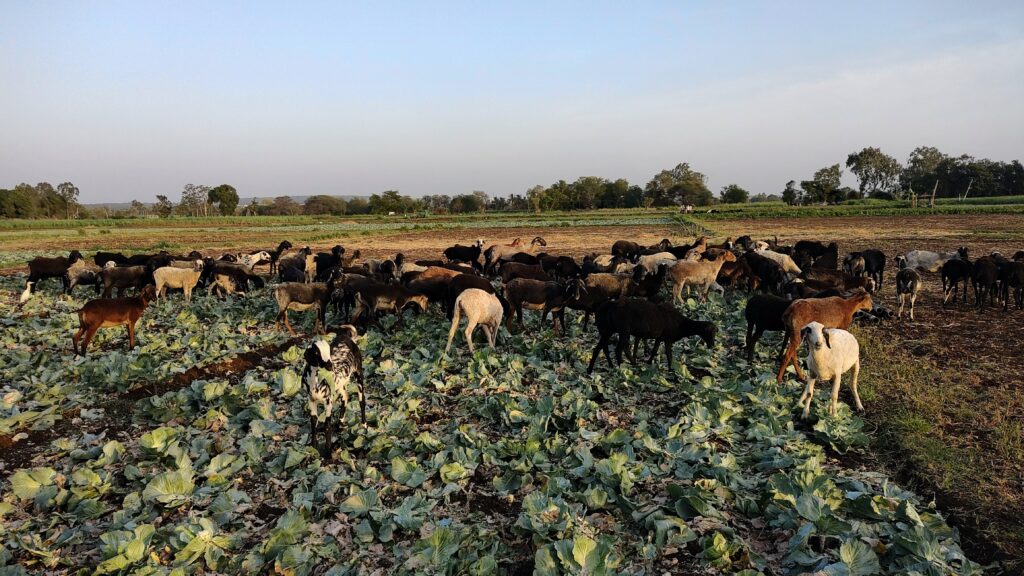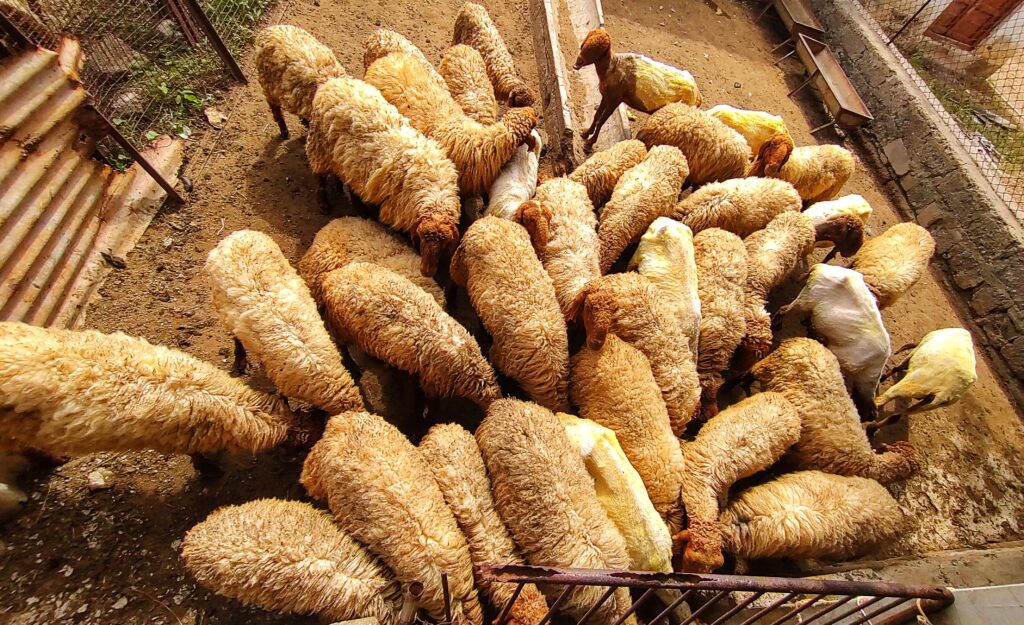Penning is an ancient and traditional practice which used to be an important aspect of the agro-pastoral economy. Penning involves camping the sheep and goats in the field at night. Sheep go out in the morning to graze. The penning of the livestock, especially in southern Indian peninsula dates back to the Southern Indian Neolithic age, which began around 3000 BCE and lasted until 1400 BCE. The presence of ‘Ash Mounds’ in the region indicates the flourishing of a very complex agro-pastoral economy during this time.
Sheep rearing is traditionally nomadic in nature. It is the primary occupation of communities like ‘Kuruma’ of Andhra Pradesh and Telangana, ‘Kuruba’ of Karnataka, ‘Dhangars’ of Maharashtra, ‘Raikas’, ‘Rabaris’ and ‘Bharwars’ of Gujarat and Rajasthan, ‘Bakerwals’ of Jammu & Kashmir, ‘Gaddis’ of Himachal Pradesh and ‘Van Gujjars’ of Uttarakhand.
All these communities rear different breeds of sheep depending on the climate zone and geography they are traditionally living in. Interestingly, the practice of penning has an indirect mention in the ancient Tamil literature. The Great Tamil Poet ‘Thiruvalluvar’ mentioned about penning in his poem ‘Thirukkural’ written in 70BC.
1. The Theory Of The Practice
The farmers approach the pastoralist who has a herd of sheep/goats. They ask him to camp his flock of sheep/goat in their farming land. This helps the farmer make his farm land nutrient rich with all the organic matter from the sheep. The nutrient rich soil makes the plants grow healthier and thus increases the yield. The organic matter in the soil holds 200 to 300% more amounts of water than the regular soil which it then supplies to the plants.
Sheep Penning Process
In the evening, pastoralists start the process of penning by assembling the herd of sheep/goat in the field. They camp the herds overnight in the open fields. Sometimes, they also fence the fields with cheap and easily available nylon net supported by iron rods of 4-5 feet. This prevents them from wild animals. This also prevents the sheep from jumping out of the nets during night.
In the morning pastoralists take the herd for grazing, usually in the radius of 1-8 km around the field. In the evening, they again camp in the field. During this time, the soil accumulates the sheep excreta and urine, making it rich with nutrients. Usually, farmers get the penning done before the cropping season. This way the farm land would have enough organic matter to help the crop grow better.
Protection of Sheep
During penning, dogs guard the sheep. The dogs also watch over a radius of 1 kilometer when the sheep graze in the fields. Shepherds raise these dogs with the ability to kill or scare away foxes, wolves and rabbits.
A Farmer’s Perspective
I belong to a farmer’s family, I have seen penning practice since my childhood but never knew its significance. When I asked my father recently about it, he said,
“Camping sheep and goat in our fields increases the organic matter in the soil which will help us get the better crop in the next season. If not for these animals, we would need to depend on chemical alternatives which are not good in the long run. We pay them in the form of grains and also provide food for them everyday during their camping time in our fields. We also know them from years so they don’t charge us.”
Nutrient Information of the Sheep Manure
The nutrient information of the sheep dung is as following. Fresh sheep dung contains 0.5-0.7% N, 0.4-0.6% P, 0.3-1.0K and Sheep urine contains 1.5-1.7% N, traces of P, and 1.8-2.0K. A herd consisting of 250 number/ acre under rain-fed condition with a penning period of an average of 5 days will save 70-80% of the total nutrient requirements.
Source: Role of Sheep Penning in Organic Farming|Crimsonpublishers.com

2. The Merits Of The Practice
- The penned field will be fertile due to the manure of sheep, which in turn promotes activity of 10 different type of organisms. The Rhizobium, Azotobacter and Azospirillum are some organisms that increase in the soil which makes it more porous
- The hibiscus grown in farmyard manure applied fields and the sheep penned fields were cooked without using any oil. They tasted better and unique as compared to the chemically grown hibiscus
- The weight of the grains from the penned fields is more
- Sheep can identify the saline patches. Its urine reduces salinity in the soil
- Scientists note taste enhancement in the vegetables grown in penned fields compared to those where chemical fertilisers were used
- The crops in the penned fields show increased vegetation (leaves and branches) compared to the fields where chemical fertilisers were used
Besides these advantages penning could also be a source of the organic manure for the farms.
Compensation
Farmers traditionally compensate the shepherds for penning their flocks on their land. The compensation is either cash or food grains or both. The farmers supply food materials to the shepherds twice a day and shepherds cook the food on their own.
Sheep Penning as Pest Management
Farmers often use sheep penning combined with grazing as a weed control mechanism. During penning, sheep add large amounts of sheep excreta to the soil which helps in the removal of weed population. According to a few experiments conducted in the Cauvery delta region of Tamil Nadu, after penning 200 sheep for eight nights, the entire land was filled with sheep excreta. And this time period was most efficient in removing the weeds in the farming land.
The high amounts of Nitrogen in the fresh sheep excreta could have been the major contributor to the vegetation change. The concentrations of ammonium N and Nitrate N in the soil were high enough to be toxic to plant roots during and after sheep penning. The loss of Nitrogen occurred later after the application of urine to the soil. The high pulse of denitrification is attributed to the significant increase in soil water soluble carbon levels and decreased oxygen, which were not conducive and sometimes even toxic to the weed plants.
Source: (PDF) Role of Sheep Penning in Organic Farming (researchgate.net)

3. Declining Sheep Penning – Impacts
These days sheep penning is on decline. The condition in Gujarat has completely changed. Initially during penning, the farmers used to pay shepherds. But these days, when the pastorals are migrating and want to camp in fields, they have to pay in thousands for camping over a month in the villages. Farmers or the village heads usually demand a hefty sum. This adds an extra cost to the sheep rearing pastoral communities. This has also changed the relationship between the pastoral communities and the farmers. The relationship between them used to be a friendly and mutually benefitting one. It has now turned into a transactional one where the pastorals have to pay to use the land.
Since the fertiliser markets are flooded with different types of affordable chemical fertilisers, the farmers no longer need penning. They have started charging the shepherds for camping in their fields. This is because the farmers believe that the shepherds are using their resources without any compensation. This transactional relationship has added extra costs to the pastoral communities.
A Shepherd’s Perspective
“Initially people used to invite us for camping in their fields on our migration routes. They used to pay us good amount of money and food as well. Times have changed and now we are paying the villagers to stay in their fields. At times, the amount we have to pay them is high, so we group up. Two or three families together pair up and pay collectively for camping in villages. Depending upon the number of animals, the amount we pay can go as high as 30,000 rupees.”
Gabru bhai, a Rabari pastoral from the Surendranagar district of Gujarat
Rise in Chemical Fertiliser Industry
The rise in the usage of chemical fertilisers is also one of the reasons for the decline in sheep penning. On average, India consumed about 500 Lakh Metric Tonnes (LMT) of fertilisers per year in the last decade. The government recently provided year-wise consumption data in the Rajya Sabha, showing the trend in the quantity of chemical fertilisers used in India since 2015-16. As per the data shared, urea is the most consumed fertiliser with around 300 LMT being consumed each year, accounting for 55% to 60% of the chemical fertiliser consumption in the country. Urea is mostly used in farming for providing the nitrogen to the plants and promoting the plant’s growth.
Source: Chemical Fertiliser consumption increased by 16% in the last six years (factly.in)
Artificially manufactured Urea is inexpensive and a cost-effective option for farmers. But it can also be harmful for the plants and contaminates the ground water.
Source: The Benefits and Risks of using Urea as a Fertiliser – AccessibleGardens
Effects on Livelihood
Since the income generated from penning for pastoral communities is almost zero, it has a great impact on their livelihoods. Now the pastoral communities depend only on selling milk and meat for their livelihoods. Since the sheep and goat milk market is not very well established and an unorganised one, the sell of animals to meat markets is on the rise. Since the wool from the sheep also has very limited value in Indian markets because of its coarseness and small staple length, the pastorals cannot depend on the sheep for wool either.
This has led to change in the breeds the pastorals rear. For example, the pastorals from Kutch who used to rear wooly breeds like Patanwadi and Marwari and now moving towards woolly breads Gari and Baradi.
These issues have made the pastoral youth move towards other livelihoods like driving trucks, tea stalls and farming. A process in transformation, sheep penning is likely to undergo many changes in the coming years.




0 Comments